2. 香港城市大学深圳研究院深圳海洋生物多样性可持续利用重点实验室, 深圳 518057;
3. 香港科技大学环境科学学科, 香港
2. Shenzhen Key Laboratory for the Sustainable Use of Marine Biodiversity, Research Centre for the Oceans and Human Health, City University of Hong Kong Shenzhen Research Institute, Shenzhen 518057, China;
3. Environmental Science Programs, the Hong Kong University of Science and Technology, Hong Kong, China
微塑料是指粒径小于5 mm的塑料颗粒[1], 由于其过小的粒径以及难降解的特性, 受到学界的广泛关注.微塑料主要来源于日用品[2]、工业添加[1]以及大块塑料的破碎[1].经过几十年积聚, 海洋中塑料垃圾不断增加, 微塑料污染也在全球范围内被广泛检测到[3].在我国, 微塑料污染也非常严重, 沿海地带如台州椒江、温州瓯江和福州闽江几个河口海岸区域的水样中微塑料(DW)的浓度为(600~1 100 items·m-3)[4], 是发达国家的30~50倍之多.环境中微塑料作为一种新型污染物对海洋环境产生危害, 其自身含有的许多有毒的添加剂如色素、增塑剂等[5]会随着微塑料在海洋中流动释放.由于粒径较小, 微塑料容易被海洋生物误食[6, 7], 随着食物链在海洋生物体内积聚.微塑料有较大的比表面积, 能够作为凝结核不断吸附海洋中的其他污染物.甚至还有研究表明, 微塑料可以作为一些小型海洋生物迁徙的载体, 随着洋流进入到外地环境中, 从而引发生物入侵现象[8, 9].
长江是欧亚大陆第一大河, 全长约6 300 km, 超过四亿人居住在长江流域[10].长江携带大量的废弃物进入中国东海, 对整个西太平洋海岸环境产生重要影响[11].长江口是长江在东海入海口的一段水域, 全长约232 km.由于人口稠密、河流流量大、水上活动多, 长江口极易受到塑料垃圾积聚的危害.根据报道, 长江口水域中的微塑料(DW)浓度达到(4 137.3±2 461.5) items·m-3[12], 相较于欧美等发达国家水域[13]来说处于一个非常高的水平, 相较于临近水域如韩国仁川周边海域[14], 水样中微塑料的浓度也达到3~5倍之多, 因此, 微塑料污染问题在长江口已刻不容缓.
沉积物在各种沉降、密度或联合沉淀等作用下, 成为海洋生态系统的“沉淀槽”和污染的第二来源[15~17].微塑料在沉积物中积聚后, 在环境改变或生物扰动等作用下, 能够重新悬浮于水面中与其他污染物结合或者释放有毒物质[18].河口地带中的各种物质如废弃物、重金属或有机污染物等, 在河流输入和海洋作用下形成盐水楔, 进而极易沉降后被掩埋在底泥沉积物环境中[19], 并且这些污染物会相互结合[20].河流中携带的物质在河口径流和潮汐的作用下, 其丰度和成分都会发生一定改变[21], 因此污染物在潮滩地带中的流动性、生物可利用性和环境毒性不可以简单地用浓度来表示[22, 23], 应该考虑其连续的作用.目前, 我国针对微塑料污染的研究集中于水体和水生生物, 本文选取长江口潮滩沉积物作为研究对象, 开展了对潮滩沉积物中微塑料污染的检测和沉积特点的初步探索.
1 材料与方法 1.1 仪器与试剂仪器:烘箱(BZF-50, 上海博讯公司).体视显微镜(M165FC, 德国Leica公司), 电子分析天平(BSA124S, 德国Sartorius), 真空抽滤系统(GM-0.33A, 天津津腾公司), 实验室常用玻璃器皿购于中国医药集团上海公司.
试剂:NaCl(分析纯)购于中国医药集团上海公司.
1.2 研究区域及样品收集与处理沉积物样品采集于东旺沙(DWS: 121°55′06″E, 31°34′08″N)、吴淞口(WSK: 121°30′33″E, 31°23′36″N)、石洞口(SDK: 121°23′50″E, 31°28′40″N)、浏河口(LHK: 121°17′45″E, 31°31′05″N)、七丫口(QYK: 121°14′37″E, 31°36′36″N)和浒浦(XP: 120°57′34″E, 31°45′33″N)共6个典型采样点站位, 如图 1所示.
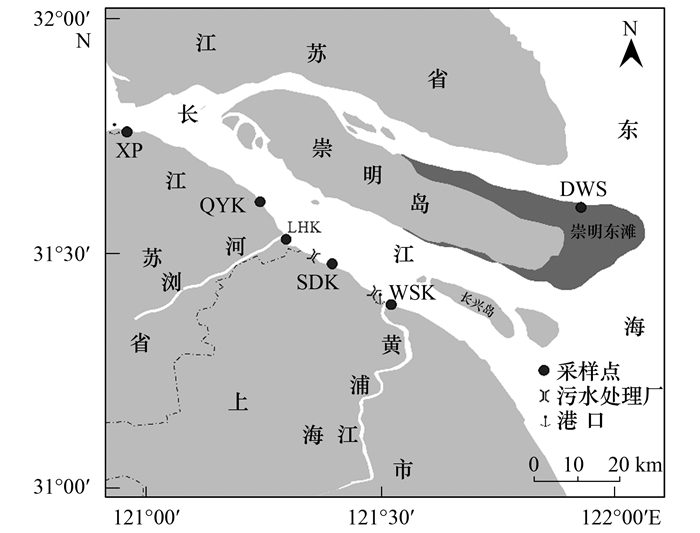
|
沿长江边从下游至上游分布, WSK:吴淞口, 石洞口:SDK, 浏河口:LHK, 七丫口:QYK和浒浦:XP; DWS:东旺沙, 位于中国第三大岛屿崇明岛 图 1 长江入海口地区采样点示意 Fig. 1 Sampling sites along the Yangtze estuary |
长江口潮滩表层(0~5 cm)沉积物样品分别于2016年4月、7月和11月以及2017年1月采集.采样时, 于低潮期使用干净不锈钢铲采集沉积物(每个采样点隔50 m取样, 共取3个平行样品), 样品用锡箔纸包裹后置于自封袋密封保存, 当天送回实验室.每份样品取部分于烘箱(BZF-50, 上海博讯公司)中烘干处理, 烘箱温度70℃, 烘干至沉积物质量恒定不再发生变化.所有样品用锡箔纸包好, 置于自封袋在4℃冰箱中保存.
1.3 沉积物中的微塑料提取实验前将NaCl溶液(300 g·L-1)通过直径47 mm, 孔径5.0 μm的玻璃纤维滤膜(GF/B, 英国Whatman公司)过滤.称取沉积物干样(n=3), 加入沉积物干样质量20倍体积的过滤后的NaCl溶液, 摇晃至均匀, 室温静置12 h.取上清液通过真空抽滤系统(GM-0.33A, 天津津腾公司), 滤膜采用直径47 mm, 孔径5.0 μm的混合硝酸纤维素膜(SMWP04700, 英国Millipore公司), 真空抽滤完成, 将滤膜置于干净的培养皿中进行微塑料检测.
1.4 沉积物中微塑料再悬浮-沉降为研究微塑料颗粒在潮滩表层沉积物中的沉降特点, 对沉积物样品进行实验室模拟再悬浮过程[24], 通过对不同层面沉积物进行微塑料检测来探索微塑料颗粒在沉积物中的沉降趋势.
取沉积物样品(未经烘干处理)置于离心管中, 加入适量去离子水, 彻底摇匀, 直至整个体系呈匀浆状(无结块).体系于4℃静置24 h直至完全沉降分层后, 12 000 r·min-1离心5 min.
离心后, 体系分为3层:澄清的悬浮相、上层稀疏的胶状沉积物、下层稠密的紧致沉积物.悬浮相直接通过混合硝酸纤维素膜(SMWP04700, 英国Millipore公司)真空过滤后, 显微镜下进行微塑料检测.上层和下层沉积物分别转移至锥形瓶中, 加入过滤后的NaCl溶液(300 g·L-1), 摇晃至均匀.室温静置12 h, 取上清液通过直径47 mm, 孔径5.0 μm的混合硝酸纤维素膜(SMWP04700, 英国Millipore公司)进行过滤, 将滤膜置于干净的培养皿中进行微塑料检测.
分别取上层、下层沉积物样品, 于烘箱(BZF-50, 上海博讯公司)中进行烘干处理, 烘箱温度70℃, 烘干至沉积物质量恒定不再发生变化.样品烘干后, 于研钵中研磨至粉末状, 进行粒度测试.粒度测试采用激光粒度分析仪(LS 13320, Beckman Coulter Corporation, USA), 每层沉积物共有3个平行.
1.5 数据处理及分析滤膜置于Leica体视镜(M165FC, 德国Leica公司)观察, 拍照.根据照片对微塑料丰度、形状特征等进行统计分析.每个实验样品设置3组平行(n=3), 所有实验数据均采用平均值±标准偏差(mean±SD)表示.实验中使用的地理信息图使用ArcGis 10.2软件进行绘制.实验结果使用GraphPad Prism 5.0软件分析及显著性检验, P<0.05表示差异具有显著性统计学意义.
2 结果与分析 2.1 微塑料在长江口潮滩表层沉积物中的形状与分布本实验选取2016年的4、7、11月和2017年1月这4个月份样品代表全年4个季度, 对吴淞口、石洞口、浏河口、七丫口、浒浦和东旺沙这6个采样点潮滩沉积物进行检测, 代表长江口潮滩沉积物中微塑料污染情况.如图 2所示, 4个季度长江口潮滩沉积物中均有不同丰度的微塑料被检测到, 且在各个采样位点中, 微塑料主要由纤维状和碎片状两种形状组成.从粒径来看, 纤维状微塑料的粒径分布较为广泛, 从100~2 500 μm均有分布, 并在500~1 000 μm区间内分布较多; 碎片状微塑料粒径分布较为集中, 大多不超过300 μm, 相对于纤维状微塑料较小.
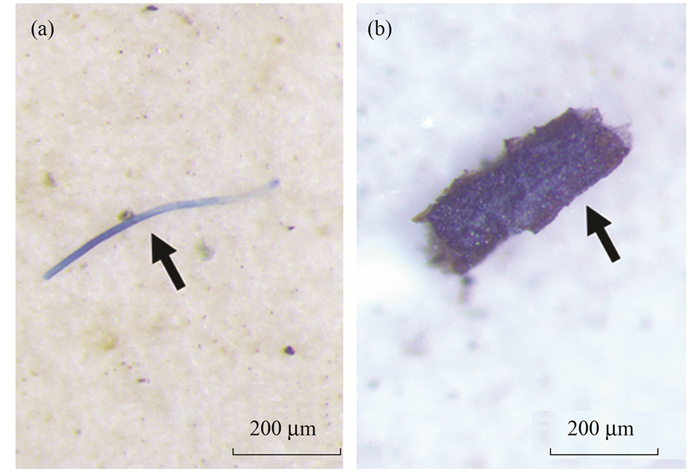
|
(a)纤维状微塑料; (b)碎片状微塑料 图 2 长江口潮滩表层沉积物中微塑料的不同存在形式 Fig. 2 Presence of microplastics in the Yangtze estuary |
如3(a)所示, 长江口潮滩6个采样点沉积物中微塑料(DW)平均丰度为(3.42±1.31) items·g-1.七丫口(QYK)为6个采样点中微塑料丰度最高的位点, 丰度为4.76 items·g-1, 显著性高于浏河口(LHK)、浒浦(XP)和石洞口(SDK) (P<0.05);吴淞口(WSK)和石洞口(SDK)也是微塑料丰度较高的位点, 丰度(以DW计)分别为4.09和4.19 items·g-1, 与其他各位点并无显著性差异(P>0.05);位于长江口上游的浏河口(LHK)、浒浦(XP)和崇明岛上的东旺沙(DWS)为微塑料丰度最低的两个位点, 丰度(以DW计)为3.18、2.93和3.19 items·g-1.
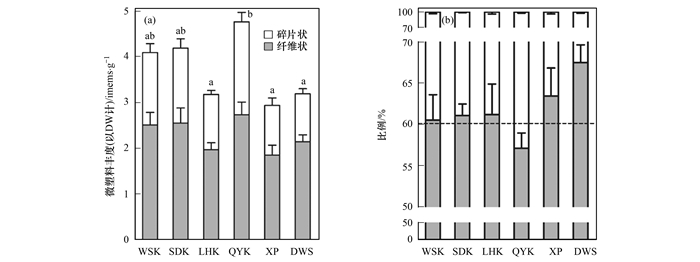
|
(a)沉积物中微塑料全年平均丰度; (b)沉积物中两种微塑料组成比例 图 3 长江口潮滩表层沉积物中微塑料污染现状(n=12) Fig. 3 Microplastics pollution status in surface sediment of the Yangtze estuary (n=12) |
如图 3(b)所示, 6个采样点中均有纤维状和碎片状两种形状的微塑料被检测到, 在所有位点中纤维状微塑料所占比例均高于碎片状微塑料, 除七丫口外其余5个位点中纤维状微塑料在60%以上. 6个采样位点中, 位于崇明岛潮滩的东旺沙沉积物中纤维状微塑料所占比例最高, 七丫口沉积物中微塑料纤维状所占比例最低, 低于60%.七丫口是微塑料丰度最高的位点, 但碎片状微塑料含量相对较高.
2.2 微塑料在长江口潮滩表层沉积物中的季度变化及规律本实验选取2016年4月、7月、11月和2017年1月这4个月份样品代表全年4个季度(表 1).长江口是长江进入东海的入海口, 背靠江苏、浙江两省和上海市, 地属亚热带湿润季风型气候, 气候温和, 降水量充沛.在长江下游地区, 每年4月会进入连续阴天降水气候, 被称为梅雨季节, 即长江口地区的雨季.长江口雨季降水量133.3 mm显著性高于旱季的降水量58.05 mm (P<0.05), 雨季低潮位高度133 cm也显著性高于旱季93 cm (P<0.05), 雨季微塑料丰度(以DW计)为(3.16±0.90)items·g-1, 显著性低于旱季(以DW计)(4.36±1.66) items·g-1 (P<0.05).这表明, 雨季的高降水量和高低潮位高度对潮滩的冲刷带走了沉积物中微塑料, 对微塑料污染有一定减缓作用.
|
|
表 1 长江口各季度气候基本信息1) Table 1 Basic weather information for the Yangtze estuary showing seasonal patterns |
各个季度中长江口潮滩沉积物中微塑料丰度变化如图 4所示. 7月为雨季末期, 降水量和低潮位高度都较高, 降水与潮汐冲刷对微塑料丰度影响较大, 仅吴淞口(WSK)微塑料丰度显著性高于另外4个位点(除七丫口外). 11月为雨季结束, 旱季开始时期, 各位点微塑料差异不明显, 仅浒浦(XP)微塑料丰度显著性低于其他位点. 4月和1月为微塑料差异较明显的季度. 1月为旱季末期, 石洞口(SDK)和七丫口(QYK)微塑料丰度显著性高于浏河口(LHK)、浒浦(XP)和东旺沙(DWS); 4月为旱季结束, 雨季开始, 七丫口(QYK)微塑料丰度显著性高于浏河口(LHK)、浒浦(XP)和东旺沙(DWS).这表明, 七丫口(QYK)等微塑料污染较严重的位点, 污染积聚时期主要为旱季, 雨季降水和潮汐的冲刷对微塑料污染积聚有着减缓作用.
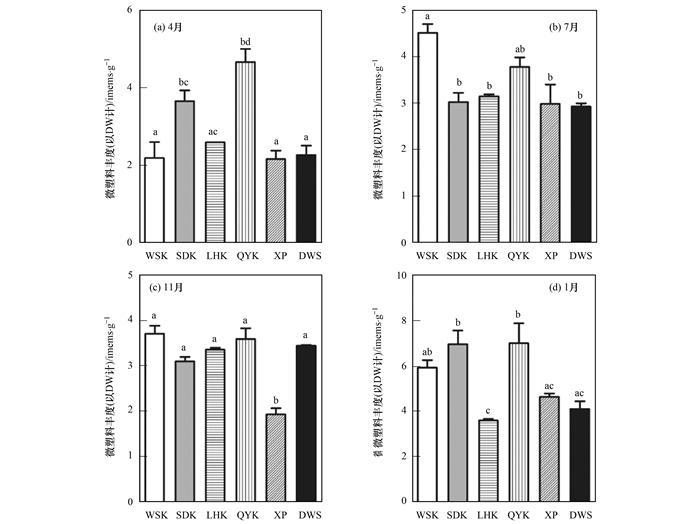
|
图 4 长江口潮滩沉积物中微塑料丰度季度特征 Fig. 4 Abundance of microplastics in different seasons in the Yangtze estuary sediment |
微塑料在长江口潮滩6个采样点表层沉积物中季度变化如5所示. 4个季度检测结果表明, 微塑料在冬季(1月)的丰度较其他3个季度有显著性升高(P<0.05), 在夏季和秋季微塑料浓度无显著性差异.通过与表 1中采样期间长江口各季度气候基本信息对比, 可以发现降水量与潮滩沉积物中微塑料丰度有着一定关联, 当降水量和降水天数较低时, 微塑料的丰度相对较高.这表明降水的冲刷会减弱微塑料的积聚, 有利于缓解微塑料污染在河口沿岸地带的积累.在不同季度的各个采样点中, 微塑料均呈现纤维状和碎片状两种不同形状, 其比例也不相同.其中, 纤维状微塑料所占比例在各个季度各个采样点均高于碎片状微塑料, 并且总体呈上升趋势.
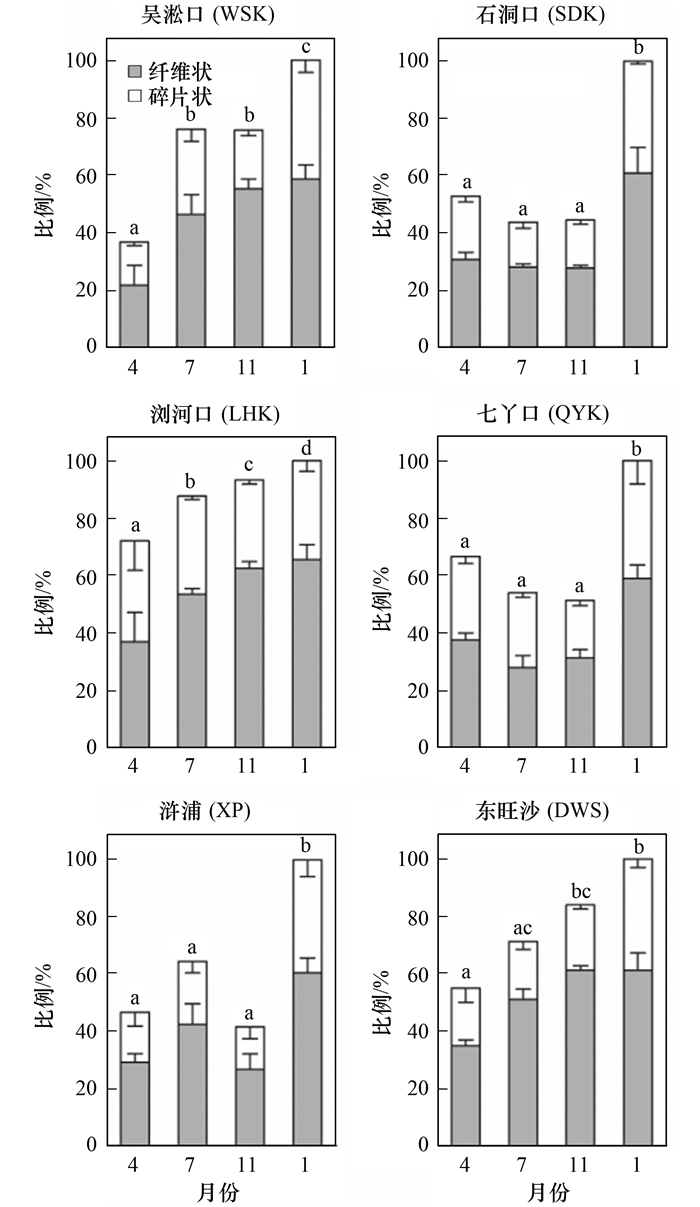
|
图 5 微塑料的形状组成在各位点的季度变化 Fig. 5 Seasonal pattern of the physical types of microplastics at each sampling site |
长江口潮滩沉积物再悬浮-沉降后, 体系分为悬浮相、上层沉积物和下层沉积物3层(图 6).上层沉积物体积占沉积物总体积60% (0~3 cm), 质量占30%;下层沉积物占总体积40%, 密度是上层沉积物3.5倍, 下层沉积物平均粒径(14.00 μm±0.69 μm)显著高于上层沉积物(6.16 μm±1.02 μm) (P<0.05).再悬浮-沉降后, 微塑料倾向于在上层沉积物和悬浮相中分布, 占微塑料总量75%以上.上层沉积物中微塑料丰度显著性高于下层沉积物(P<0.05).对微塑料形态进行统计分析发现, 总体上纤维状微塑料数量要多于碎片状, 但沉积物越深, 碎片状微塑料所占比例越高, 即碎片状微塑料更易向更下层沉积物积聚, 而纤维状微塑料更倾向于在上层或者悬浮相间隙水中积聚.
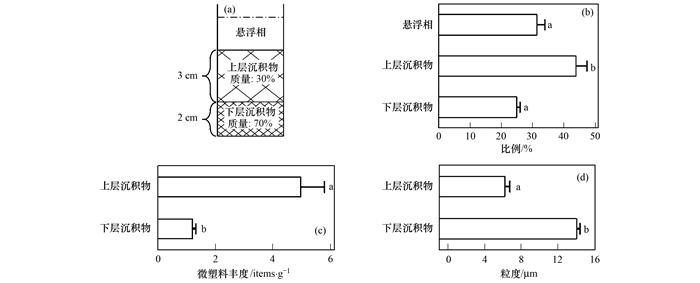
|
(a)深度-3~0 cm为上层沉积物, -5~-3 cm为下层沉积物; (b)沉降后微塑料在沉积物中各层分布(n=3); (c)沉降后微塑料在沉积物中各层丰度(n=3); (d)沉降后上、下层沉积物粒度 图 6 微塑料在表层沉积物中的再悬浮后沉降特点示意 Fig. 6 Re-distribution of microplastics in sediment after re-settlement |
从形态上看, 长江口潮滩沉积物中微塑料的形状组成与比例, 与环境[12, 25]和海洋生物体内[26]微塑料形态检测结果相符合.长江口潮滩沉积物中微塑料丰度与长江口气候变化的关联性,降水对沉积物的冲刷会对沉积物中微塑料丰度有较大影响, 与Lima等的发现一致[27].各位点的微塑料丰度与冲淤情况有着较高的一致性, 长江口是长江向海洋输送物质的重要地段, 水体中的微塑料在长江口径流与潮汐共同作用下, 容易沉降积聚在沉积物中, 因此长江口沉积物的冲淤对于微塑料的积聚有着重要影响, 在浒浦和浏河口冲刷强于淤积的位点[28], 微塑料丰度较低; 在七丫口、石洞口和吴淞口淤积强于冲刷的位点[28], 微塑料丰度较高.同时, 临近污水处理厂、港口等工业活动的吴淞口、石洞口和七丫口, 潮滩沉积物中微塑料丰度高于浒浦和东旺沙, 表明人类活动对微塑料污染也有着重要影响.
长江口潮滩沉积物中微塑料丰度检测结果与长江口河口表层水[12]中微塑料(以DW计)浓度[(4.03±2.40) items·g-1]相近, 低于北部湾[29]沉积物中微塑料浓度(6.92 items·g-1), 远高于近海海底沉积物中微塑料丰度[(0.121±0.009) items·g-1][25], 近海海底沉积物中微塑料丰度为潮滩沉积物的1%~2%.通过比较长江口潮滩与中国内陆河流区域的微塑料污染现状发现, 内陆河流区域更为严重.中国三峡大坝地区长江支流水域[5]微塑料浓度达到192.5~11 889.7 items·g-1, 是长江口潮滩地区100~2 500倍, 这表明径流和潮汐双重作用下的河口区域微塑料的污染程度低于内陆河流区域.微塑料污染在国内外河口区域潮滩沉积物中都被检测到, 如美国佐治亚海岸潮滩[30].与国外河流、河口区域微塑料污染相比, 中国微塑料污染问题十分突出.美国切萨皮克湾表层水样[31]中微塑料含量仅(1.96×10-13±6.94×10-14) items·g-1, 远远低于长江口表层水样; 德国内陆河流莱茵河流域潮滩表层沉积物[32]中微塑料含量为4 items·g-1, 远远低于中国内陆三峡流域污染水平.
3.2 微塑料在沉积物中再悬浮-沉降特点长江口潮滩沉积物经再悬浮-沉降后分层与各层粒度与之前关于沉积物再悬浮沉降研究结果相符[24].通过实验室模拟微塑料在沉积物中的再悬浮沉降过程, 微塑料在沉积物中的分布与Green等[33]的结果相符合.潮滩表层沉积物是污染积聚严重的区域[34], 也是许多海洋生物如底栖生物的栖息地.研究表明, 微塑料自身可以作为凝结核对其他污染有一定吸附作用[35].微塑料倾向于在表层沉积物中分布, 与其他污染物容易结合可能性增加, 产生的联合毒性也可能增强.长江口潮滩沉积物近十年的沉降速率约为6.4 cm·a-1[36], 因此潮滩沉积物中的微塑料污染大多分布于潮滩近年内的沉积物中, 而难以进入更底层沉降的沉积物中.对于长江口潮滩沉积物中微塑料污染问题的研究, 可能要重点关注近年来沉积物的影响.
4 结论本文研究结果表明:微塑料在长江口潮滩沉积物中积聚, 全年平均丰度(以DW计)为(3.42±1.31) items·g-1, 主要有纤维状和碎片状两种存在形式, 其中纤维状所占比例较高.微塑料的积聚受到降水、河流冲淤等环境因素影响较大, 高降水量和河流冲刷会降低潮滩沉积物中微塑料的积聚.微塑料更易在潮滩表层沉积物中积聚, 难以进入深层沉积物中.
| [1] | Andrady A L. Microplastics in the marine environment[J]. Marine Pollution Bulletin, 2011, 62(8): 1596-1605. DOI:10.1016/j.marpolbul.2011.05.030 |
| [2] | Fendall L S, Sewell M A. Contributing to marine pollution by washing your face:microplastics in facial cleansers[J]. Marine Pollution Bulletin, 2009, 58(8): 1225-1228. DOI:10.1016/j.marpolbul.2009.04.025 |
| [3] | Van Cauwenberghe L, Devriese L, Galgani F, et al. Microplastics in sediments:a review of techniques, occurrence and effects[J]. Marine Environmental Research, 2015, 111: 5-17. DOI:10.1016/j.marenvres.2015.06.007 |
| [4] | Zhang K, Gong W, Lv J Z, et al. Accumulation of floating microplastics behind the Three Gorges Dam[J]. Environmental Pollution, 2015, 204: 117-123. DOI:10.1016/j.envpol.2015.04.023 |
| [5] | Teuten E L, Rowland S J, Galloway T S, et al. Potential for plastics to transport hydrophobic contaminants[J]. Environmental Science & Technology, 2007, 41(22): 7759-7764. |
| [6] | Desforges J P W, Galbraith M, Ross P S. Ingestion of microplastics by zooplankton in the northeast Pacific Ocean[J]. Archives of Environmental Contamination and Toxicology, 2015, 69(3): 320-330. DOI:10.1007/s00244-015-0172-5 |
| [7] | Van Cauwenberghe L, Claessens M, Vandegehuchte M B, et al. Microplastics are taken up by mussels (Mytilus edulis) and lugworms (Arenicola marina) living in natural habitats[J]. Environmental Pollution, 2015, 199: 10-17. DOI:10.1016/j.envpol.2015.01.008 |
| [8] | Teuten E L, Saquing J M, Knappe D R U, et al. Transport and release of chemicals from plastics to the environment and to wildlife[J]. Philosophical Transactions of the Royal Society of London. Series B, Biological Sciences, 2009, 364(1526): 2027-2045. DOI:10.1098/rstb.2008.0284 |
| [9] | Gregory M R. Environmental implications of plastic debris in marine settings-entanglement, ingestion, smothering, hangers-on, hitch-hiking and alien invasions[J]. Philosophical Transactions of the Royal Society of London. Series B, Biological Sciences, 2009, 364(1526): 2013-2025. DOI:10.1098/rstb.2008.0265 |
| [10] | Chen Z Y, Li J F, Shen H T, et al. Yangtze River of China:historical analysis of discharge variability and sediment flux[J]. Geomorphology, 2001, 41(2-3): 77-91. DOI:10.1016/S0169-555X(01)00106-4 |
| [11] | Li M T, Xu K Q, Watanabe M, et al. Long-term variations in dissolved silicate, nitrogen, and phosphorus flux from the Yangtze River into the East China Sea and impacts on estuarine ecosystem[J]. Estuarine, Coastal and Shelf Science, 2007, 71(1-2): 3-12. DOI:10.1016/j.ecss.2006.08.013 |
| [12] | Zhao S Y, Zhu L X, Wang T, et al. Suspended microplastics in the surface water of the Yangtze Estuary System, China:first observations on occurrence, distribution[J]. Marine Pollution Bulletin, 2014, 86(1-2): 562-568. DOI:10.1016/j.marpolbul.2014.06.032 |
| [13] | Corcoran P L, Norris T, Ceccanese T, et al. Hidden plastics of Lake Ontario, Canada and their potential preservation in the sediment record[J]. Environmental Pollution, 2015, 204: 17-25. DOI:10.1016/j.envpol.2015.04.009 |
| [14] | Chae D H, Kim I S, Kim S K, et al. Abundance and distribution characteristics of microplastics in surface seawaters of the Incheon/Kyeonggi Coastal Region[J]. Archives of Environmental Contamination and Toxicology, 2015, 69(3): 269-278. DOI:10.1007/s00244-015-0173-4 |
| [15] | Dang D H, Lenoble V, Durrieu G, et al. Seasonal variations of coastal sedimentary trace metals cycling:Insight on the effect of manganese and iron (oxy)hydroxides, sulphide and organic matter[J]. Marine Pollution Bulletin, 2015, 92(1-2): 113-124. DOI:10.1016/j.marpolbul.2014.12.048 |
| [16] | Schintu M, Buosi C, Galgani F, et al. Interpretation of coastal sediment quality based on trace metal and PAH analysis, benthic foraminifera, and toxicity tests (Sardinia, Western Mediterranean)[J]. Marine Pollution Bulletin, 2015, 94(1-2): 72-83. DOI:10.1016/j.marpolbul.2015.03.007 |
| [17] | Alomar C, Estarellas F, Deudero S. Microplastics in the Mediterranean Sea:deposition in coastal shallow sediments, spatial variation and preferential grain size[J]. Marine Environmental Research, 2016, 115: 1-10. DOI:10.1016/j.marenvres.2016.01.005 |
| [18] | Prajith A, Rao V P, Chakraborty P. Distribution, provenance and early diagenesis of major and trace metals in sediment cores from the Mandovi estuary, western India[J]. Estuarine, Coastal and Shelf Science, 2016, 170: 173-185. DOI:10.1016/j.ecss.2016.01.014 |
| [19] | Wang G G, Peng J L, Hao T, et al. Distribution and region-specific sources of Dechlorane plus in marine sediments from the coastal East China Sea[J]. Science of the Total Environment, 2016, 573: 389-396. DOI:10.1016/j.scitotenv.2016.08.090 |
| [20] | Roig N, Sierra J, Moreno-Garrido I, et al. Metal bioavailability in freshwater sediment samples and their influence on ecological status of river basins[J]. Science of the Total Environment, 2016, 540: 287-296. DOI:10.1016/j.scitotenv.2015.06.107 |
| [21] | Gao S, Wang Y P. Changes in material fluxes from the Changjiang River and their implications on the adjoining continental shelf ecosystem[J]. Continental Shelf Research, 2008, 28(12): 1490-1500. DOI:10.1016/j.csr.2007.02.010 |
| [22] | Moore F, Nematollahi M J, Keshavarzi B. Heavy metals fractionation in surface sediments of Gowatr Bay-Iran[J]. Environmental Monitoring and Assessment, 2015, 187: 4117. DOI:10.1007/s10661-014-4117-7 |
| [23] | Palleyi S, Banoo S, Kar R N, et al. Textural and geochemical characteristics of off shore sediment of North Bay of Bengal:a statistical approach for marine metal pollution[J]. International Journal of Sediment Research, 2015, 30(3): 208-222. DOI:10.1016/j.ijsrc.2014.09.001 |
| [24] | Huang L D, Li Z X, Bai X L, et al. Laboratory study of phosphorus retention and release by eutrophic lake sediments:modeling and implications for P release assessments[J]. Ecological Engineering, 2016, 95: 438-446. DOI:10.1016/j.ecoleng.2016.06.089 |
| [25] | Peng G Y, Zhu B S, Yang D Q, et al. Microplastics in sediments of the Changjiang Estuary, China[J]. Environmental Pollution, 2017, 225: 283-290. DOI:10.1016/j.envpol.2016.12.064 |
| [26] | Li J N, Qu X Y, Su L, et al. Microplastics in mussels along the coastal waters of China[J]. Environmental Pollution, 2016, 214: 177-184. DOI:10.1016/j.envpol.2016.04.012 |
| [27] | Lima A R A, Barletta M, Costa M F. Seasonal distribution and interactions between plankton and Microplastics in a tropical estuary[J]. Estuarine, Coastal and Shelf Science, 2015, 165: 213-225. DOI:10.1016/j.ecss.2015.05.018 |
| [28] | 刘杰, 赵德招, 程海峰. 长江口南支河床近期冲淤演变机制[J]. 水运工程, 2011(7): 113-118. |
| [29] | Qiu Q X, Peng J P, Yu X B, et al. Occurrence of Microplastics in the coastal marine environment:first observation on sediment of China[J]. Marine Pollution Bulletin, 2015, 98(1-2): 274-280. DOI:10.1016/j.marpolbul.2015.07.028 |
| [30] | Lee R F, Sanders D P. The amount and accumulation rate of plastic debris on marshes and beaches on the Georgia coast[J]. Marine Pollution Bulletin, 2015, 91(1): 113-119. DOI:10.1016/j.marpolbul.2014.12.019 |
| [31] | Yonkos L T, Friedel E A, Perez-Reyes A C, et al. Microplastics in four estuarine rivers in the Chesapeake Bay, U. S. A.[J]. Environmental Science & Technology, 2014, 48(24): 14195-14202. |
| [32] | Klein S, Worch E, Knepper T P. Occurrence and spatial distribution of Microplastics in river shore sediments of the Rhine-Main Area in Germany[J]. Environmental Science & Technology, 2015, 49(10): 6070-6076. |
| [33] | Green D S, Boots B, O'Connor N E, et al. Microplastics affect the ecological functioning of an important biogenic habitat[J]. Environmental Science & Technology, 2017, 51(1): 68-77. |
| [34] | Yu R L, Hu G R, Lin C Q, et al. Contamination of heavy metals and isotopic tracing of Pb in intertidal surface sediments of Jinjiang River Estuary, SE China[J]. Applied Geochemistry, 2017, 83: 41-49. DOI:10.1016/j.apgeochem.2016.12.025 |
| [35] | Luís L G, Ferreira P, Fonte E, et al. Does the presence of Microplastics influence the acute toxicity of chromium (Ⅵ) to early juveniles of the common goby (Pomatoschistus microps)? A study with juveniles from two wild estuarine populations[J]. Aquatic Toxicology, 2015, 164: 163-174. DOI:10.1016/j.aquatox.2015.04.018 |
| [36] | 张敬, 杜金洲, 张文祥, 等. 基于210Pb、228Th和7Be三种放射性核素的长江口潮滩沉积速率研究——以崇明东滩为例[A]. 见: 第十届中国河口海岸学术研讨会论文集[C]. 北京: 中国海洋学会, 中国海洋湖沼学会, 2007. 246-251. |
 2018, Vol. 39
2018, Vol. 39


